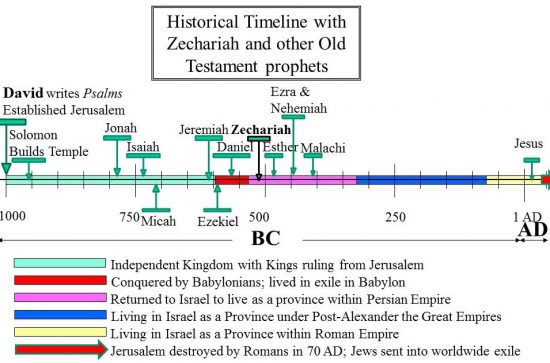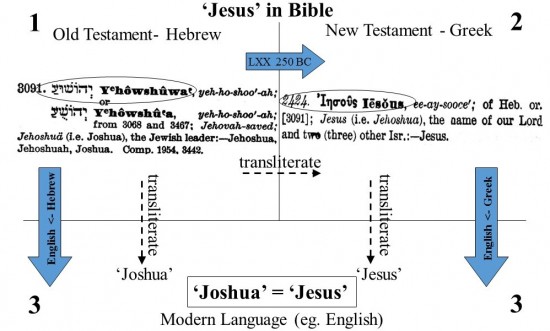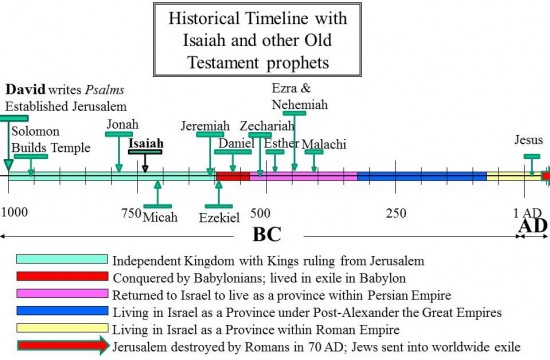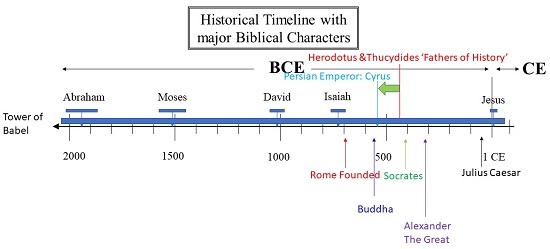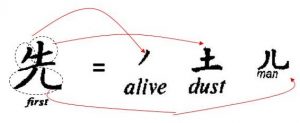Jews are one of the most ancient peoples in the world. The Bible, ancient historians outside the Bible, as well as archeology, all record their history. We have more facts about their history than that of any other nation. We will use this information to summarize their history. To make the history of the Israelites (an Old Testament word for the Jewish people) easier to follow, we will use timelines.
Abraham: The Jewish Family Tree Begins
The timeline starts with Abraham. God promised that through him God would bless all nations. Then God tested him in the symbolic sacrifice of his son Isaac. This was a sign pointing to Jesus by marking the future location of his sacrifice. God then named Isaac’s son Israel. The timeline continues in green when Israel’s descendants were slaves in Egypt. This period began with Joseph, son of Israel (the genealogy was: Abraham -> Isaac -> Israel (also known as Jacob) -> Joseph). He led the Israelites to Egypt, where later on the Egyptians enslaved them.
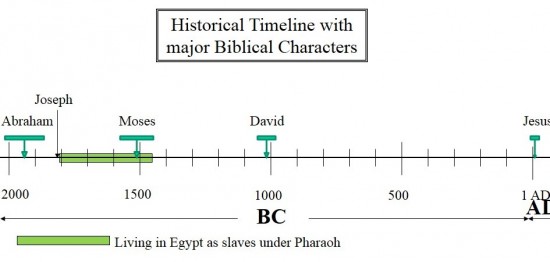
Moses: The Israelites become a Nation under God
Moses led the Israelites out of Egypt by the Passover Plague, which destroyed Egypt and allowed the Israelite Exodus from Egypt to the land of Israel. Before he died, Moses announced Blessings and Curses on the Israelites (when the timeline goes from green to yellow). God would bless their obedience but curse them if they did not obey. These Blessings & Curses would follow the Jewish people ever after.

For several hundred years the Israelites lived in their land but they did not have a King, nor did they have the capital city of Jerusalem. However, with King David at 1000 BCE this changed.

David establishes a Royal Dynasty at Jerusalem
David conquered Jerusalem and made it his capital city. He received the promise of a coming ‘Christ’. From that time on the Jewish people waited for the ‘Christ’ to come. His son Solomon, rich and famous, succeeded him and built the First Jewish Temple on Mount Moriah in Jerusalem. The descendants of King David continued to rule for about 400 years. This was the period of Israelite glory – they had the promised Blessings. They were a powerful nation; had an advanced society, rich culture, and a magnificent Temple. The timeline shows this period in aqua-blue (1000 – 600 BCE).
But the Old Testament also describes their growing corruption during this time. Many prophets in this period warned the Israelites that the Curses of Moses would come if they did not repent. But the Isralite nation ignored their warnings. During this time the Israelites divided into two separate kingdoms. There was the northern Kingdom of Israel or Ephraim, and the southern Kingdom of Judah. This is like Koreans today, one people split in two countries – North and South Korea.
The First Jewish Exile to Babylon
Finally around 600 BCE the Curses happened. Nebuchadnezzar, a powerful Babylonian King came just like Moses had predicted 900 years before when he wrote in his Curse:
The Lord will bring a nation against you from far away, from the ends of the earth, like an eagle swooping down, a nation whose language you will not understand, 50 a fierce-looking nation without respect for the old or pity for the young. 51 They will devour the young of your livestock and the crops of your land until you are destroyed. They will leave you no grain, new wine or olive oil, nor any calves of your herds or lambs of your flocks until you are ruined. 52 They will lay siege to all the cities throughout your land until the high fortified walls in which you trust fall down. They will besiege all the cities throughout the land the Lord your God is giving you.
Deuteronomy 28: 49-52)
Nebuchadnezzar conquered Jerusalem, burned it, and destroyed the Temple that Solomon had built. He then exiled the Israelites to Babylon. This fulfilled the predictions of Moses that:
Just as it pleased the Lord to make you prosper and increase in number, so it will please him to ruin and destroy you. You will be uprooted from the land you are entering to possess.
64 Then the Lord will scatter you among all nations, from one end of the earth to the other. There you will worship other gods—gods of wood and stone, which neither you nor your ancestors have known.
Deuteronomy 28:63-64

So for 70 years, the period shown in red, the Israelites lived as exiles outside the land promised to Abraham and his descendants. The term Jews began in this period in reference to their foremost tribe Judah.
Return from Exile under the Persians
After their exile, the Persian Emperor Cyrus conquered Babylon and Cyrus became the most powerful person in the world. He permitted the Jews to return to their land.

However they were no longer an independent country, they were now a province in the Persian Empire. This continued for 200 years, shown in pink in the timeline. During this time the Jews rebuilt the Jewish Temple (known as the 2nd Temple) and the city of Jerusalem. Though the Persians permitted the Jews to return to the land of Israel, many remained abroad in exile.
The period of the Greeks
Then Alexander the Great conquered the Persian Empire and made the Israelites a province in the Greek Empires for another 200 years. The timeline shows this period in dark blue.

The Period of the Romans
Then the Romans defeated the Greek Empires and they became the dominant world power. The Jews again became a province in this Empire. The timeline shows this period in light yellow. This is the time when Jesus lived. This explains why there are Roman soldiers in the gospels. The Romans ruled the Jews in Israel during the life of Jesus.

The Second Jewish exile under the Romans
From the time of the Babylonians (586 BCE) the Jews had not been independent. A succession of other empires ruled them. The Jews resented this and they revolted against Roman rule. The Romans came and destroyed Jerusalem (70 CE), and burned down the 2nd Temple. Then they deported the Jews as slaves across the Roman Empire. This was the second Jewish exile. With the vastness of the Roman Empire the Jews eventually scattered around the whole world.

This is how the Jewish people lived for almost 2000 years, dispersed in foreign lands and never totally accepted there. In these different nations they regularly suffered great persecutions. This persecution of the Jews was particularly true in Europe. From Spain, in Western Europe, to Russia the Jews lived often in a dangerous situations in these kingdoms. Jews emigrated to India and Kaifeng, China to escape these persecutions. The Curses of Moses back in 1500 BCE were accurate descriptions of how they lived.
… Among those nations you will find no repose, no resting place for the sole of your foot. There the Lord will give you an anxious mind, eyes weary with longing, and a despairing heart.
Deuteronomy 28:65
God gave the Curses against the Israelites to make peoples ask:
All the nations will ask: “Why has the Lord done this to this land? Why this fierce, burning anger?”
Deuteronomy 29:24
And the answer:
And the answer will be: “It is because this people abandoned the covenant of the Lord, the God of their ancestors, the covenant he made with them when he brought them out of Egypt. 26 They went off and worshiped other gods and bowed down to them, gods they did not know, gods he had not given them. 27 Therefore the Lord’s anger burned against this land, so that he brought on it all the curses written in this book. 28 In furious anger and in great wrath the Lord uprooted them from their land and thrust them into another land, as it is now.”
Deuteronomy 29: 25-28
The timeline below shows this 1900 year period as a long red bar.
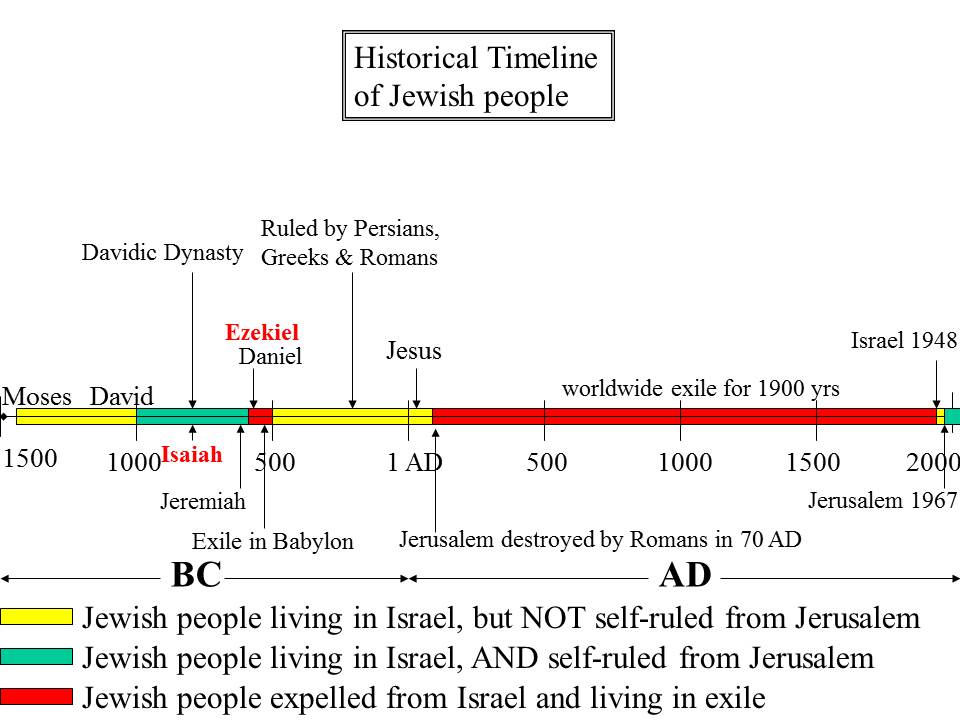
Note that the Jewish people went through two periods of exile. But the second exile was much longer than the first exile. an the first exile.
The 20th Century Holocaust
The persecutions against the Jews peaked when Hitler, through Nazi Germany, tried to exterminate all the Jews living in Europe. Six million Jews lost their lives in what today we know as the Holocaust. Hitler almost succeeded but he was defeated and a remnant of Jews survived.
Modern Re-birth of Israel
The fact that there were people who self-identified as ‘Jews’ after thousands of years without a homeland was remarkable. During this period the Jews even lost their native language, Hebrew. But this allowed the final words of Moses, written down 3500 years ago, to come true. In 1948 the world, through the United Nations, saw the incredible re-birth of the modern state of Israel. This fulfilled what Moses had written centuries before regarding how their exile would end.
then the Lord your God will restore your fortunes[a] and have compassion on you and gather you again from all the nations where he scattered you. 4 Even if you have been banished to the most distant land under the heavens, from there the Lord your God will gather you and bring you back. 5 He will bring you to the land that belonged to your ancestors, and you will take possession of it. He will make you more prosperous and numerous than your ancestors.
Deuteronomy 30:3-5
The Jews established their modern state of Israel in spite of great opposition. Most of the surrounding nations waged war against Israel in 1948 … in 1956 … in 1967 and again in 1973. Israel, a very small nation, was sometimes at war with five nations at the same time. Yet not only did Israel survive, but her territory increased. In the 1967 Six-Day War, Israel regained Jerusalem, her historic capital city David had founded 3000 years ago. The creation of the state of Israel, and the consequences of these wars, has created one of the most difficult geo-political tensions of our world today.
As Moses predicted (explored further here), the re-birth of Israel created an impetus for Jews to return to Israel. Per Moses’ blessing they are being ‘gathered’ from the most ‘distant lands’ and being brought ‘back’. Moses wrote that both Jews and non-Jews should note the implications.

